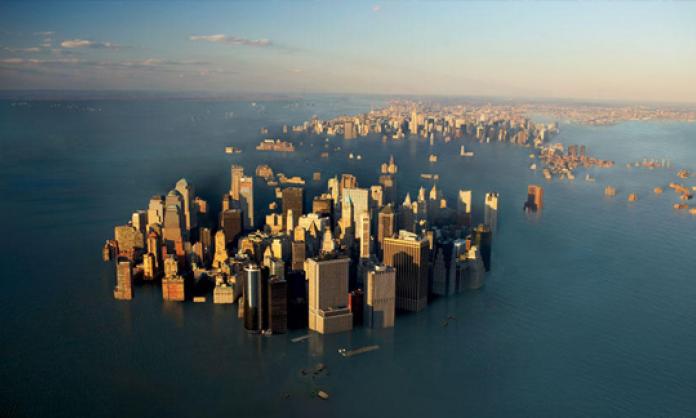A fifth of the world’s population could be forced to move to higher ground due to rising seas caused by climate change. This is the alarming “best case” scenario of a new study published in the journal Nature Climate Change.
The study, “Consequences of twenty-first-century policy for multi-millennial climate and sea-level change”, was authored by a team of 22 climate scientists led by Peter Clark from Oregon State University. The researchers took a “multi-millennial” approach – examining data from the past 20,000 years and forecasting the potential impacts of climate change up to 10,000 years into the future.
Under the worst case scenario, seas rise by more than 50 metres, with temperatures up to 7 degrees above what they are today.
The longer term perspective is necessary, according to the scientists, to take account of the life span of carbon dioxide in the atmosphere. “A considerable fraction of the carbon emitted to date and in the next 100 years will remain in the atmosphere for tens to hundreds of thousands of years”, they write.
The study considers a number of different emissions scenarios. In the best case, cumulative carbon emissions are limited to a total of 1,280 gigatons. Given historical emissions of 580 gigatons, and a current emissions rate of around 10 gigatons a year, this figure will be reached in as little as 70 years. In the worst case scenario, cumulative emissions reach 5,120 gigatons.
Based on current trends, there is little reason to hope we can limit emissions to the lower-level scenario. The December UN climate conference in Paris was touted as a significant breakthrough. Yet under the pledges made at the conference, emissions will continue increasing at least through to 2030.
Even if we’re able to limit cumulative emissions to 1,280 gigatons, the consequences for humanity will be devastating. The majority of the world’s glaciers will disappear, and large swathes of the gigantic ice sheets covering Greenland and Antarctica will melt.
Sea levels will continue to rise for thousands of years, reaching a height 25 metres above their present level. Major world cities like New York, Buenos Aires, Bombay, Cairo, Shanghai, Bangkok and Dhaka will be all but completely drowned.
Under the worst case scenario, seas rise by more than 50 metres, with temperatures up to 7 degrees above what they are today.
According to the study, “to avoid severe impacts, there is a need for policies that lead to a new global energy system that has net-zero or net-negative CO2 emissions, and not simply for policies aimed at near-term emissions reductions”.
This would be quite straightforward to achieve. The technology is there, and so is the money. Greenpeace estimates that the cost of transitioning to a 100 percent renewable world energy system by 2050 would be around US$1 trillion a year. This compares with annual global military spending of more than US$1.7 trillion, or the estimated US$3.1 trillion yearly lost to tax evasion.
There is a way. What’s lacking is the will. The world’s capitalist ruling class has grown rich on the back of a fossil fuel-dependent system. Change on the scale required is simply too much of a challenge to the interests of too many of the world’s most powerful people.
These people will continue to trash the planet for as long as they can get away with it. They reap all of the benefits and bear none of the costs. The task for the rest of us is to stop them. For increasing numbers of people around the world, this is a matter of life or death.











